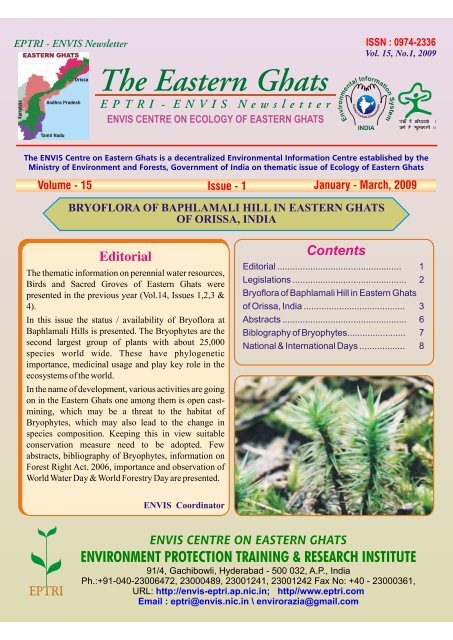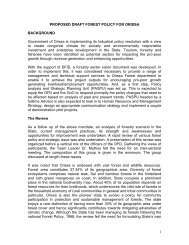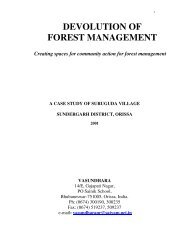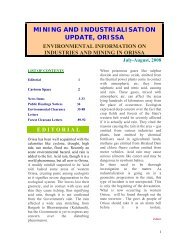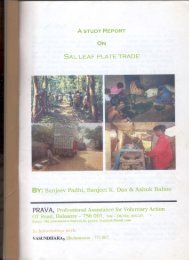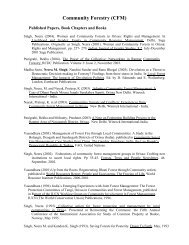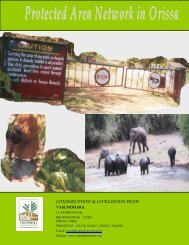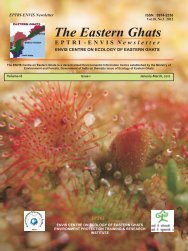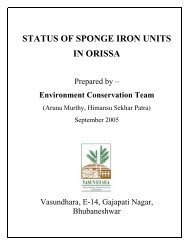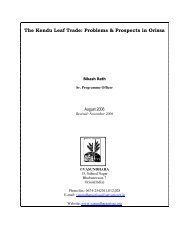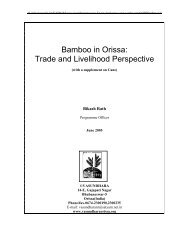Bryoflora of Baphalimali hill ranges in Eastern Ghats ... - Vasundhara
Bryoflora of Baphalimali hill ranges in Eastern Ghats ... - Vasundhara
Bryoflora of Baphalimali hill ranges in Eastern Ghats ... - Vasundhara
- No tags were found...
You also want an ePaper? Increase the reach of your titles
YUMPU automatically turns print PDFs into web optimized ePapers that Google loves.
EASTERN GHATSISSN : 0974-2336Vol. 15, No.1, 2009OrissaKarnatakaAndhra PradeshENVIS CENTRE ON ECOLOGY OF EASTERN GHATSTamil NaduThe ENVIS Centre on <strong>Eastern</strong> <strong>Ghats</strong> is a decentralized Environmental Information Centre established by theM<strong>in</strong>istry <strong>of</strong> Environment and Forests, Government <strong>of</strong> India on thematic issue <strong>of</strong> Ecology <strong>of</strong> <strong>Eastern</strong> <strong>Ghats</strong>Volume - 15 Issue - 1January - March, 2009BRYOFLORA OF BAPHLAMALI HILL IN EASTERN GHATSOF ORISSA, INDIAEditorialThe thematic <strong>in</strong>formation on perennial water resources,Birds and Sacred Groves <strong>of</strong> <strong>Eastern</strong> <strong>Ghats</strong> werepresented <strong>in</strong> the previous year (Vol.14, Issues 1,2,3 &4).In this issue the status / availability <strong>of</strong> <strong>Bry<strong>of</strong>lora</strong> atBaphlamali Hills is presented. The Bryophytes are thesecond largest group <strong>of</strong> plants with about 25,000species world wide. These have phylogeneticimportance, medic<strong>in</strong>al usage and play key role <strong>in</strong> theecosystems <strong>of</strong> the world.In the name <strong>of</strong> development, various activities are go<strong>in</strong>gon <strong>in</strong> the <strong>Eastern</strong> <strong>Ghats</strong> one among them is open castm<strong>in</strong><strong>in</strong>g,which may be a threat to the habitat <strong>of</strong>Bryophytes, which may also lead to the change <strong>in</strong>species composition. Keep<strong>in</strong>g this <strong>in</strong> view suitableconservation measure need to be adopted. Fewabstracts, bibliography <strong>of</strong> Bryophytes, <strong>in</strong>formation onForest Right Act. 2006, importance and observation <strong>of</strong>World Water Day & World Forestry Day are presented.ContentsEditorial ................................................. 1Legislations ............................................. 2<strong>Bry<strong>of</strong>lora</strong> <strong>of</strong> Baphlamali Hill <strong>in</strong> <strong>Eastern</strong> <strong>Ghats</strong><strong>of</strong> Orissa, India ........................................ 3Abstracts ................................................. 6Biblography <strong>of</strong> Bryophytes....................... 7National & International Days .................. 8ENVIS Coord<strong>in</strong>atorENVIS CENTRE ON EASTERN GHATSENVIRONMENT PROTECTION TRAINING & RESEARCH INSTITUTE91/4, Gachibowli, Hyderabad - 500 032, A.P., IndiaPh.:+91-040-23006472, 23000489, 23001241, 23001242 Fax No: +40 - 23000361,URL: http://envis-eptri.ap.nic.<strong>in</strong>; http//www.eptri.comEmail : eptri@envis.nic.<strong>in</strong> \ envirorazia@gmail.com
EPTRI - ENVIS Newsletter Vol. 15, No.1, 2009ISSN No: 0974-2336Volume : 15, Issue : 1 Year: 2009Editorial TeamDr. Razia Sultana,Mr. I. Siva Rama Krishna,Mr. Prabhata Kumar Swa<strong>in</strong>,Mr. B.L.N. Murty,Mrs. J.V.S. Prabhavati,ENVIS Coord<strong>in</strong>atorPublished bySupported bySr. Program OfficerProgram OfficerProgram AssistantEPTRI, Hyderabad.Data Entry OperatorM<strong>in</strong>istry <strong>of</strong> Environment and Forests (MoEF),Government <strong>of</strong> India, New DelhiInstructions to ContributorsENVIS Newsletter on Ecology <strong>of</strong> <strong>Eastern</strong> <strong>Ghats</strong> is aquarterly publication publishes the articles related tothe thematic area <strong>of</strong> the ENVIS Centre. Authors arerequested to send their articles, write-ups, on thethemes perta<strong>in</strong><strong>in</strong>g to Biological, Physical, Socio-Econonic Environments, Programmes & Policiesand Information Systems <strong>of</strong> <strong>Eastern</strong> <strong>Ghats</strong>.Readers are requested to k<strong>in</strong>dly visit the website:http://envis-eptri.ap.nic.<strong>in</strong>.Expert Database Form and Querry Rsponse Form areavailable <strong>in</strong> the website.Experts <strong>in</strong> the above fields are requested to downloadthe Expert Database Form, fill up and send to us.Whoever <strong>in</strong>tends to seek <strong>in</strong>formation on the ecology<strong>of</strong> <strong>Eastern</strong> <strong>Ghats</strong> may k<strong>in</strong>dly download the QuerryResponse Form, fillup and send us.The filled <strong>in</strong> forms can be sent by post to EnvisCoord<strong>in</strong>ator, ENVIS Centre on <strong>Eastern</strong> <strong>Ghats</strong>,EPTRI, Gachibowli, Hyd. or Fax at 040-23000361 oremail : eptri@envis.nic.<strong>in</strong> / envirorazia@gmail.comLEGISLATIONSFOREST RIGHTS ACT, 2006After acrimonious public debate for more than a years<strong>in</strong>ce tabl<strong>in</strong>g <strong>in</strong> the parliament <strong>in</strong> December 2005, theScheduled Tribes (Recognition <strong>of</strong> Forest Rights) Bill,2005 which was re-christened as “The ScheduledTribes and Other Traditional Forest Dwellers(Recognition <strong>of</strong> Forest Rights) Act, 2006” was passed<strong>in</strong> the parliament. The Act came <strong>in</strong>to force s<strong>in</strong>ceDecember 2006.The Forest Rights Act (to use its convenientshort form) provides for a series <strong>of</strong> rights forscheduled tribes (which are listed <strong>in</strong> India’sconstitution) and other traditional forest-dwell<strong>in</strong>gcommunities over land that they have occupied forcultivation or residence, and also over forest produceand traditional knowledge. It gives legalempowerment to communities to manage and protectforests.The Forest Rights Act has generated debateover its social and ecological implications. Inparticular, a number <strong>of</strong> conservationists have beenvociferously opposed to it, claim<strong>in</strong>g that it will be thedeath-knell <strong>of</strong> India’s forests and wildlife. Manysocial activists on the other hand feel that it will notonly provide the basic rights that forest-dwell<strong>in</strong>gcommunities should have been granted decades back,but will also lead to enhanced conservation <strong>of</strong> forests.A number <strong>of</strong> groups and <strong>in</strong>dividuals have taken more<strong>of</strong> a ‘middle path’, po<strong>in</strong>t<strong>in</strong>g out that severalprovisions <strong>of</strong> the Act could favor conservation whileothers could lead to deforestation, and that thebenefits accru<strong>in</strong>g to forest-dwellers from the Actcould be substantial <strong>in</strong> some places, peripheral <strong>in</strong>others. How precisely the Act will play will dependon a number <strong>of</strong> policy and ground-level factors,<strong>in</strong>clud<strong>in</strong>g the level <strong>of</strong> mobilization and cohesion <strong>of</strong>forest-dwell<strong>in</strong>g communities <strong>in</strong> a particular area, thesensitivity <strong>of</strong> government <strong>of</strong>ficials adm<strong>in</strong>ister<strong>in</strong>g theAct and the ecological fragility <strong>of</strong> the area.2
EPTRI - ENVIS NewsletterVol. 15, No.1, 2009BRYOFLORA OF BAPHLAMALI HILL IN EASTERN GHATS OF ORISSA, INDIA* **P.K. DASH , D.K. SAHU and D.K. SAXENA*Biodiversity Conservation Division, <strong>Vasundhara</strong>, Orissa, India**Department <strong>of</strong> Botany, Bareilly College, Bareilly, U P, India.AbstractThirty one species <strong>of</strong> bryophytes compris<strong>in</strong>g 20liverworts, 9 mosses and 2 hornworts are be<strong>in</strong>greported for the first time from Baphlamali <strong>hill</strong><strong>ranges</strong> from the <strong>Eastern</strong> <strong>Ghats</strong> <strong>of</strong> India dur<strong>in</strong>g thesurvey conducted from January 2007 to November2008. Some <strong>of</strong> the noteworthy species areConocephalum conicum, Dumortiera hirsuta,Targionia hypophylla, Pallavic<strong>in</strong>ia lyelli,Lophocolea bidentata, Pellia epiphylla, Frullaniamuscicola, Frullania squarrosa and Plagiochasmaappendiculatu.IntroductionThe <strong>Eastern</strong> <strong>Ghats</strong> are isolated <strong>hill</strong> <strong>ranges</strong> <strong>in</strong>Pen<strong>in</strong>sular India (Andhra Pradesh, Orissa, TamilNadu and Karnataka), harbors primarily tropicalmoist deciduous vegetation, which representsspecies <strong>of</strong> high economic, timber, medic<strong>in</strong>al0 0 0potential, lies <strong>in</strong> 11 30' to 21 0' N Latitudes and 77022' to 85 20' E Longitudes. <strong>Eastern</strong> <strong>Ghats</strong> are highlysignificant <strong>in</strong> terms <strong>of</strong> its biodiversity. Of theestimated 3,200 flower<strong>in</strong>g plant taxa, there are about528 tree taxa under 271 genera belong<strong>in</strong>g to 80families (Reddy et al., 2007) distributed <strong>in</strong> differentregions <strong>of</strong> <strong>Eastern</strong> <strong>Ghats</strong>. In total 454 species under243 genera and 78 families are endemic to <strong>Eastern</strong><strong>Ghats</strong>. Based on geological and tectonicconsiderations, the <strong>Eastern</strong> <strong>Ghats</strong> <strong>in</strong> Orissa startsfrom North <strong>of</strong> Similipal <strong>in</strong> Mayurbhanj district andruns through Malkangiri. Seventeen districts <strong>of</strong>Orissa come under the <strong>Eastern</strong> <strong>Ghats</strong> <strong>in</strong>clud<strong>in</strong>g 14protected areas (13 wild life sanctuaries, oneBiosphere reserve, one National Park, two tigerreserve and one Ramser Wetland). Baphlaimali issituated <strong>in</strong> the southwestern part <strong>of</strong> Orissa, falls <strong>in</strong> theNorth <strong>Eastern</strong> Ghat belt <strong>in</strong> the pen<strong>in</strong>sular shield withthe highest peak <strong>of</strong> 1056 m above msl. between 19°18’ to 19° 22’ N longitude and 82° 56’ to 82° 59’ Elatitude and comes under Kashipur block <strong>of</strong>Rayagada district and rest <strong>in</strong> Koraput districts <strong>of</strong>Orissa. Baphlimali is one <strong>of</strong> the rich bauxite depositareas <strong>in</strong> the <strong>Eastern</strong> <strong>Ghats</strong> <strong>of</strong> India. Accord<strong>in</strong>g toChampion and Seth (1968), the vegetation <strong>of</strong> the <strong>hill</strong>3is basically <strong>of</strong> tropical moist deciduous type withmany riparian evergreen elements. The averageannual ra<strong>in</strong>fall is 1485 mm; the maximumtemperature goes up to 42ÚC and the m<strong>in</strong>imum dropsto 5ÚC. The relative humidity is normally high dur<strong>in</strong>gthe monsoon and post-monsoon months sometimesbe<strong>in</strong>g more than 85% which favours growth <strong>of</strong>bryophytes <strong>in</strong> the <strong>hill</strong>s. There are no surface waterbodies on the top <strong>of</strong> the platue, but many <strong>of</strong> the <strong>hill</strong>streams are orig<strong>in</strong>ated from the top storey <strong>of</strong> the <strong>hill</strong>sprovide amicable environment and multiple habitatfor the growth <strong>of</strong> Bryophytes. Bryophytes constitute agroup <strong>of</strong> non-flower<strong>in</strong>g plants which <strong>in</strong>cludes mosses,liverworts and hornworts. Despite their small size,they comprise major components <strong>of</strong> the biomass andphotosynthetic production (Frego, 2007) <strong>in</strong> forestecosystems. Bryophytes are widely used asbio<strong>in</strong>dicators <strong>of</strong> environment for their unique and veryspecific responses as some species are extremelysensitive to pollutants and exhibit visible <strong>in</strong>jurysymptoms even <strong>in</strong> the presence <strong>of</strong> very m<strong>in</strong>utequantities <strong>of</strong> pollutants (Sahu et al., 2007). Theyhave several biological features mak<strong>in</strong>g themparticularly suited to serve as study organism <strong>in</strong>macroevolutionary, population genetics andecological research. Bryophytes are used <strong>in</strong>medic<strong>in</strong>es, household purposes, horticulture,agriculture, fuel <strong>in</strong> <strong>in</strong>dustries and as ecological<strong>in</strong>dicators throughout the world (Nath & Asthana.,2005). Bryophytes are the second largest group <strong>of</strong>plants, with about 25,000 species worldwide (Buckand G<strong>of</strong>f<strong>in</strong>etnet, 2000). About 2000 species <strong>of</strong>mosses, 816 species <strong>of</strong> liverworts and 34 species <strong>of</strong>hornworts are occurr<strong>in</strong>g <strong>in</strong> India <strong>in</strong> the present state <strong>of</strong>our knowledge. The plants are distributed <strong>in</strong> <strong>Eastern</strong>and Western Himalayas, South India and Central India(Nath & Asthana, 2005). Despite <strong>of</strong> their diversity,phylogenetic importance, medic<strong>in</strong>al uses and key role<strong>in</strong> the ecosystems <strong>of</strong> the world, no study has beencarried out on bryophytes <strong>of</strong> Orissa. An attempt hasbeen made for the first time to explore and documentthe Bryophytes <strong>of</strong> <strong>Eastern</strong> <strong>Ghats</strong> <strong>of</strong> Orissa.Materials and methodsThe study was undertaken from January 2005 toDecember 2007. Keep<strong>in</strong>g <strong>in</strong> view <strong>of</strong> the hygrophilous
EPTRI - ENVIS NewsletterVol. 15, No.1, 2009nature <strong>of</strong> the bryophytes the sampl<strong>in</strong>g was conductedseasonally. The aquatic, terrestrial and epiphyticbryophytes were collected <strong>in</strong> polythene bags andbrought to the laboratory, washed and dried. Thespecimens were identified after exam<strong>in</strong><strong>in</strong>g thespecial features like elaters, rhizoids, sporophytediameter, etc. The doubtful specimens wereidentified by match<strong>in</strong>g with the herbarium specimensat National Botanical Research Institute, Lucknow.The voucher specimens were kept <strong>in</strong> bryophyteherbarium <strong>of</strong> Utkal University, Bhubaneswar withproper accession numbers.Results and discussionIn total 31 Species <strong>of</strong> bryophytes <strong>in</strong>clud<strong>in</strong>g 20liverworts, 2 hornworts and 9 mosses under 17 familyand 22 genera are reported here for the first time fromthe Baphlamali <strong>hill</strong>s <strong>in</strong> the <strong>Eastern</strong> <strong>Ghats</strong> <strong>of</strong> India(Table 1). All the species reported here are newdistributional records <strong>of</strong> occurrence for the State.Species like Anthoceros angustus, Conocephalumconicum, Lophocolea bidentata, Pallavic<strong>in</strong>ia lyellii,Pellia epiphylla, Polytrichum juniper<strong>in</strong>um andTargionia <strong>in</strong>dica were encountered between altitudes<strong>of</strong> 550 m to 870 m, where the forest is mostly moistdeciduous type with small semi-evergreen patcheshav<strong>in</strong>g closer canopy. Four species such asPhaeoceros laevis ssp. carol<strong>in</strong>ianus, Asterellaangusta, Heteroscyphus argutus and Riccardialevierii were collected between altitudes <strong>of</strong> 250 m to680 m <strong>in</strong>dicat<strong>in</strong>g its adaptation towards vary<strong>in</strong>gmicro-climatic conditions. Five species like Ricciatrichocarpa, Herpet<strong>in</strong>euron toccoae, Cyathodiumcavernarum, Funaria hygrometrica and Ricciaglauca were collected from m<strong>in</strong><strong>in</strong>g areas harbour<strong>in</strong>gdry deciduous forest with more open canopy.Dumortiera hirsuta and Plasiochasmaappendiculatum showed a wide range <strong>of</strong>morphological variation along the altitud<strong>in</strong>al gradientwith<strong>in</strong> the <strong>hill</strong> <strong>ranges</strong>. Mossess like Entodontopsiswightii, Polytrichum juniper<strong>in</strong>um and P<strong>in</strong>natellacalcutensis were collected from high altitudes rang<strong>in</strong>gfrom 750 to 900 m above msl.The present study <strong>in</strong>dicates that Baphlamali <strong>hill</strong><strong>ranges</strong> are rich <strong>in</strong> bryophytes. Currently the criticalhabitat <strong>of</strong> the bryophytes is under threat aga<strong>in</strong>st theongo<strong>in</strong>g anthropogenic activities like open castm<strong>in</strong><strong>in</strong>g <strong>in</strong> this region. The changes <strong>in</strong> the microhabitat<strong>of</strong> bryophytes may seriously affect the speciescomposition very rapidly and thus upset theecological balance. Keep<strong>in</strong>g <strong>in</strong> view the immenseecological importance <strong>of</strong> this lower group <strong>of</strong> plantssuitable conservation measures should be taken topreserve the bry<strong>of</strong>lora <strong>of</strong> the <strong>hill</strong>s. Studies are <strong>in</strong>progress to document the <strong>Bry<strong>of</strong>lora</strong> <strong>of</strong> the Northern<strong>Eastern</strong> <strong>Ghats</strong> <strong>of</strong> India.Table 1 Checklist <strong>of</strong> Bryophytes <strong>of</strong> Baphlamali Hills along with Altitud<strong>in</strong>al Variation4
EPTRI - ENVIS Newsletter Vol. 15, No.1, 2009LL - Leafy liverworts, TL - Thallus liverworts, MS - Mosses, HW – Hornworts.Marchantia palmata NeesPlagiochasma appendiculatumlehm et L<strong>in</strong>denbPallavic<strong>in</strong>ia lyellii (Hook.) CarruthPolytrichum juniper<strong>in</strong>um Hedw.5
EPTRI - ENVIS NewsletterPellia epiphylla (L.) CordaVol. 15, No.1, 2009Press, Delhi, 1968.Frego, K.A. Bryophytes as potential <strong>in</strong>dicators <strong>of</strong>forest <strong>in</strong>tegrity. Forest Ecology andManagement., 2007, 242, 65–75.Nath, V. and Asthana, A. K. Studies on IndianBryophytes, 50 years <strong>of</strong> National BotanicalResearch Institute (eds.) P. Pushpangadan, S.Kumar & V.K. Kochhar., 2005, pp 277-288.Sahu, V., Asthana, A.K., Nath, V and Yunus, M.Bryophytes: A Useful Tool <strong>in</strong> Heavy MetalMonitor<strong>in</strong>g, Archives <strong>of</strong> Enviro News,Newsletter <strong>of</strong> ISEB India Vol. 13 No. 4. 2007.Reddy, C.S., Reddy, K.N., Murthy, E.N and Raju, V.S,2009. Tree Wealth <strong>of</strong> <strong>Eastern</strong> <strong>Ghats</strong> <strong>of</strong> AndhraPradesh, India: An updated checklist. CheckList 5(2): 173–194.ABSTRACTRiccia glauca L.AcknowledgmentsThe authors are grateful to the Concern World Wide,Bangalore for provid<strong>in</strong>g f<strong>in</strong>ancial support to carryout the study. The Director <strong>of</strong> <strong>Vasundhara</strong>, Orissa isthankful for his k<strong>in</strong>d support and Dr. Virendra Nath,the Head <strong>of</strong> Bryology Division, NBRI, Lacknow ishighly acknowledged <strong>in</strong> identify<strong>in</strong>g the doubtfulspecimens.ReferencesBuck, W.R. and G<strong>of</strong>f<strong>in</strong>et, B. Morphology andclassification <strong>of</strong> mosses. Bryophyte Biology(eds.) A. J. Shaw & B. G<strong>of</strong>f<strong>in</strong>et. CambridgeUniversity Press, University <strong>of</strong> Cambridge,UK, 2000.Champion, H.G. and Seth, S.K. A Revised Survey <strong>of</strong>the Forest Types <strong>of</strong> India. Govt. <strong>of</strong> IndiaPattanaik, C., C. S. Reddy and M.S.R. Murthy. 2008.An ethnobotanical survey <strong>of</strong> medic<strong>in</strong>al plants usedby the Didayi tribe <strong>of</strong> Malkangiri district <strong>of</strong> Orissa,IndiaFitoterapia, 79(1): 67-71An ethnobotanical survey was carried outamong the ethnic community (Didayi) <strong>in</strong> Malkangiridistrict, Orissa. A total <strong>of</strong> 53 medic<strong>in</strong>al plant speciesbelong<strong>in</strong>g to 34 families and 52 different species aredescribed under this study.Krishna Prasad, V., K.V.S. Badar<strong>in</strong>ath and A. Eaturu.2008. Biophysical and anthropogenic controls <strong>of</strong>forest fires <strong>in</strong> the Deccan Plateau, India Journal <strong>of</strong>Environmental Management, 86(1): 1-13Forest fires constitute one <strong>of</strong> the most seriousenvironmental problems <strong>in</strong> several forested regions<strong>of</strong> India. In the Indian sub-cont<strong>in</strong>ent, relatively fewstudies have focused on the assessment <strong>of</strong>biophysical and anthropogenic controls <strong>of</strong> forestfires at a landscape scale and the spatial aspects <strong>of</strong>these relationships. In this study, we used fire countdata sets from satellite remote sens<strong>in</strong>g data cover<strong>in</strong>g78 districts over four different states <strong>of</strong> the DeccanPlateau, India, for assess<strong>in</strong>g the underly<strong>in</strong>g causes <strong>of</strong>fires. Spatial data for explanatory variables <strong>of</strong> firesperta<strong>in</strong><strong>in</strong>g to topography, vegetation, climate,6
BIBLIOGRAPHY OF BRYOPHYTESEPTRI - ENVIS Newsletteranthropogenic and accessibility factors have beengathered correspond<strong>in</strong>g with fire presence/absence. Alogistic regression model was used to estimate theprobability <strong>of</strong> the presence <strong>of</strong> fires as a function <strong>of</strong> theexplanatory variables. Results for fire area estimates2suggested that, <strong>of</strong> the total fires cover<strong>in</strong>g 47,043kmthat occurred dur<strong>in</strong>g the year 2000 for the entireIndian region, 29.0% occurred <strong>in</strong> the Deccan Plateau,with Andhra Pradesh hav<strong>in</strong>g 13.5%, Karnataka14.7%, Kerala 0.1%, and Tamilnadu 1.15%. Resultsfrom the logistic regression suggest that the strongest<strong>in</strong>fluences on the fire occurrences were the amount <strong>of</strong>forest area, biomass densities, rural populationdensity (PD), average precipitation <strong>of</strong> the warmestquarter, elevation (ELE) and mean annualtemperature (MAT). Among these variables, biomassdensity (BD) and average precipitation <strong>of</strong> thewarmest quarter had the highest significance,followed by others. These results on the bestpredictors <strong>of</strong> forest fires can be used both as a strategicplann<strong>in</strong>g tool to address broad scale fire riskconcerns, and also as a tactical guide to help forestmanagers to design fire mitigation measures at thedistrict level.Behera, S. K. and M. K. Misra. 2006. Abovegroundtree biomass <strong>in</strong> a recover<strong>in</strong>g tropical sal (Shorearobusta Gaertn. f.) forest <strong>of</strong> <strong>Eastern</strong> <strong>Ghats</strong>, India.Biomass and Bioenergy, 30(6): 509-521Aboveground biomass <strong>of</strong> <strong>in</strong>dividual treespecies by component and total biomass per unit areafor four different stages <strong>of</strong> a recover<strong>in</strong>g tropical drydeciduous forest stands, dom<strong>in</strong>ated by sal (Shorearobusta Gaertn. f.) <strong>of</strong> the <strong>Eastern</strong> <strong>Ghats</strong>, India were<strong>in</strong>vestigated dur<strong>in</strong>g 2001–2002. Different periods <strong>of</strong>recover<strong>in</strong>g (2, 4, 6, and 10-year) forest stands (84°132E, 20°292 N) were selected <strong>in</strong> the Kandhamal district<strong>of</strong> Orissa, India and sample trees <strong>of</strong> all species wereharvested. Tree species diversity was 23, 23, 21 and22 <strong>in</strong> 2, 4, 6, and 10-year recover<strong>in</strong>g stands,respectively. Species-wise Ixora pavetta showed thehighest biomass <strong>in</strong> 2 and 4-year stands while Shorearobusta <strong>in</strong> 6 and 10-year stands. Component-wise, <strong>in</strong>all species, bole–wood contribution ranged between22.6% and 60.9%. Aboveground tree biomass, <strong>in</strong> allthe stands, was dom<strong>in</strong>ated by Shorea robusta, which”1ranged between 12.68 and 231.91 Mg ha . Totalaboveground tree biomass was 30.12, 49.21, 107.54”1and 261.08 Mg ha <strong>in</strong> 2, 4, 6 and 10-year stands,respectively.7Vol. 15, No.1, 2009BIBLIOGRAPHY OF BRYOPHYTESAhmad, S. 1942. Three new species <strong>of</strong> Riccia from India.Curr. Sci. 11: 433 – 434.Asthana, A.K. & S.C. Srivastava. 1991. Indian Hornworts(A taxonomic study). Bryophyt. Biblioth. 42: 1 –158.Asthana, G. 2001. Present status <strong>of</strong> the genus Cololejeunea<strong>in</strong> India. In: V. Nath & A.K. Asthana (ed.),Perspectives <strong>in</strong> Indian Bryology, 209 – 217.Dehra DunAsthana, G., S.C. Srivastava & A.K. Asthana 1995. Thegenus Cheilolejeunea <strong>in</strong> India. L<strong>in</strong>dbergia 20:125 – 143.Awasthi, U.S. 1986. The genus Leptolejeunea (Spruce)Steph. <strong>in</strong> India. J. Indian Bot. Soc. 65: 117 – 123.Awasthi, U.S. & R. Udar. 1984. The genus Mastigolejeunea(Spruce) Schiffn. <strong>in</strong> India. Proc. Indian Acad.Sci. (Pl. Sci.) 93: 485 – 494.Bapna, K.R. 1968. A new record <strong>of</strong> Petalophyllum <strong>in</strong>dicumKash. From Western <strong>Ghats</strong>. Curr. Sci. 37: 173 –175.Bapna, K.R. & B.L. Chaudary. 1980. Contributions onIndian Hepatics I. (1951 – 1960). Misc. Bryol.Lichénol. 8: 169 – 172.Bapna, K.R. & B.L. Chaudary. 1981a. Contributions onIndian Hepatics II. (1961 – 1970). Misc. Bryol.Lichénol. 9: 18 – 23.Bapna, K.R. & B.L. Chaudary. 1981b. Contributions onIndian Hepatics III. (1971 – 1980). Misc. Bryol.Lichénol. 9: 59 – 63.Bapna, K.R. & B.L. Chaudary. 1982. Contributions onIndian Hepatics III. (1971 – 1980). Misc. Bryol.Lichénol. 9: 93 – 94.Bruehl, P. 1931. A census <strong>of</strong> Indian mosses with analyticalkeys to the genera. Rec. Bot. Surv. India 13(1): 1– 135; 13(2): 1 – 152.Chopra, R.S. 1943. A census <strong>of</strong> Indian Hepatics. J. IndianBot. Soc. 22: 237 – 260.Chopra, R.S. 1975. Taxonomy <strong>of</strong> Indian mosses. NewDelhi.Daniels, A.E.D. 1998. Ecological adaptations <strong>of</strong> somebryophytes <strong>of</strong> the Western <strong>Ghats</strong>. J. Ecobiol. 10:261 – 270.Daniels, A.E.D. 2001. Cololejeunea furcilobulata (Berrieet Jones) Schuster and Heteroscyphus argutus(Re<strong>in</strong>w. et al.) Schiffn. from Mahendragiri <strong>hill</strong>s<strong>of</strong> Kanyakumari District <strong>of</strong> South India. In:Nath, V. & A.K. Asthana (ed.), Perspectives <strong>in</strong>Indian Bryology, 301 – 307. Dehra Dun.Daniels, A.E.D. 2004. Bryophytes. In: Annamalai, R. (ed.),Tamil Nadu Biodiversity Strategy and Actionplan.Wild Plant Diversity: 49 - 70. Government<strong>of</strong> Tamil Nadu, Chennai.
EPTRI - ENVIS NewsletterNATIONAL & INTERNATIONAL DAYSWORLD WATER DAYWater is an astonish<strong>in</strong>g substance-centre <strong>of</strong> life. Itnourishes our nations, drives our <strong>in</strong>dustries, washesaway our scrap, satisfies our thirst and br<strong>in</strong>gs beautyand pleasure <strong>in</strong>to our lives. It is a paradox that theworld is <strong>in</strong> <strong>in</strong>exorably mov<strong>in</strong>g towards an era <strong>of</strong> watershortage despite water constitut<strong>in</strong>g three-fourths <strong>of</strong>ndthe earth’s surface. March 22 was first deemed asWorld Water Day <strong>in</strong> 1993 by the United NationsConference on Environment and Development(UNCED) as an <strong>in</strong>ternational day <strong>of</strong> observance andaction to draw attention to the role that fresh waterplays <strong>in</strong> our world and lives. Emerg<strong>in</strong>g water scarcityhas the potential to wreak economic and ecologicalhavoc on the planet on the com<strong>in</strong>g decades.Unsusta<strong>in</strong>able exploitation <strong>of</strong> deep aquifers to cater togrow<strong>in</strong>g population, pollution <strong>of</strong> surface waters byuntreated sewage, pesticides, fertilizers and <strong>in</strong>dustrialchemicals, <strong>in</strong>efficient agriculture use and the impact<strong>of</strong> climate change are all affect<strong>in</strong>g the world’s wateravailability.Today’s reality is that one <strong>in</strong> eight people <strong>in</strong> the worlddon’t have access to safe water. Poor countries are atgreater risk <strong>of</strong> fac<strong>in</strong>g the ravage <strong>of</strong> water scarcity. TheWorld Heath organization proposed years ago thataccess to water must be made a basic human right witha duty cast on government to take targeted steps for itsrealization, that would <strong>in</strong>clude legislative measures tomake the right enforceable.The water is be<strong>in</strong>g mismanaged and unsusta<strong>in</strong>ablyused. India’s huge economic growth and mount<strong>in</strong>gpopulation is pitt<strong>in</strong>g an acute stra<strong>in</strong> on waterresources. The country has seventeen percent <strong>of</strong> theworld’s population, but only 2 percent <strong>of</strong> the world’sland and 4 percent <strong>of</strong> the water resources. It isestimated that 40 percent <strong>of</strong> communicable diseases <strong>in</strong>India are related to unsafe water. Diarrhea alonecauses more than 2000 deaths. There had already beenan alarm<strong>in</strong>g decl<strong>in</strong>e <strong>in</strong> ground water levels <strong>in</strong> manystates.In Andhra Pradesh , river pollution, depletion <strong>of</strong>ground water and land ward movement <strong>of</strong> seawaterhave been noticed. Sea water has already <strong>in</strong>trudedupto 30 km. <strong>in</strong> the coastal belt. The <strong>in</strong>trusion <strong>of</strong>seawater <strong>in</strong> river estuaries upsett<strong>in</strong>g the hydrologicalVol. 15, No.1, 2009balance <strong>in</strong> nearby villages. The ground water levels aredepleted due to <strong>in</strong>discrim<strong>in</strong>ate drill<strong>in</strong>g <strong>of</strong> water.The fifth World Water Forum <strong>in</strong> Istanbul (Turky)thndstarted on 15 March and ended on 22 March (onWorld Water Day), with a pledge by more than 100countries to strive to provide clean water and propersanitation. The forum is held every three years. around25,000 policymakers and grassroots workers took part.THE WORLD FORESTRY DAYWorld Forestry Day is celebrated around the world onst21 March every year as people take time to considerthe benefits <strong>of</strong> forest to the community - such ascatchments protection, provid<strong>in</strong>g habitat for animalsand plants, areas for recreation, education andscientific study and as a source <strong>of</strong> many products<strong>in</strong>clud<strong>in</strong>g timber and honey.The concept <strong>of</strong> hav<strong>in</strong>g a World Forestry Day orig<strong>in</strong>atedrdat the 23 General Assembly <strong>of</strong> the EuropeanConfederation <strong>of</strong> Agriculture <strong>in</strong> 1971. Later that year,the United Nations Food and Agriculture Organizationgave support to the idea <strong>of</strong> believ<strong>in</strong>g that the eventwould contribute a great deal to public awareness onthe importance <strong>of</strong> forests and agreed that it should bestobserved every year around the world on March 21 .The day is chosen to dissem<strong>in</strong>ate <strong>in</strong>formation on theimportance <strong>of</strong> forestry, its protection, production anduse for recreation.stWorld Forestry Day was observed on 21 March, 2009by <strong>of</strong>ficials <strong>of</strong> the Nilgiris South Forest Division at theSree Vivekananda Vidyalaya Primary School,Udhagamandalam, Tamilnadu run by the Rotary Club<strong>of</strong> Ootacamund <strong>in</strong> Theetukkal on Saturday. Address<strong>in</strong>gthe students, the president <strong>of</strong> the Club, Mr. B.R.Bhirman, said that "Children should play an active role<strong>in</strong> enhanc<strong>in</strong>g environmental awareness among varioussections <strong>of</strong> society". Plant<strong>in</strong>g <strong>of</strong> 50 sapl<strong>in</strong>gs marked theoccasion.Source: The H<strong>in</strong>du, March 22, 2009The Energy and Resources Institute (TERI) <strong>in</strong>association with M<strong>in</strong>istry <strong>of</strong> Environment and Forestsst(MoEF) celebrated World Forestry Day on 21 March2009. The dignitaries present on the occasion were Mr.Vijai Sharma, Secretary MoEF, Padmashri Dr AnilJoshi, Mr. M.B. Lal, ADGF (Wildlife), Mr. A K Johari,DIG (RT) and Ms. Ranjana Saikia, Fellow TERI.Source: The Economic Times, March 21, 20098


